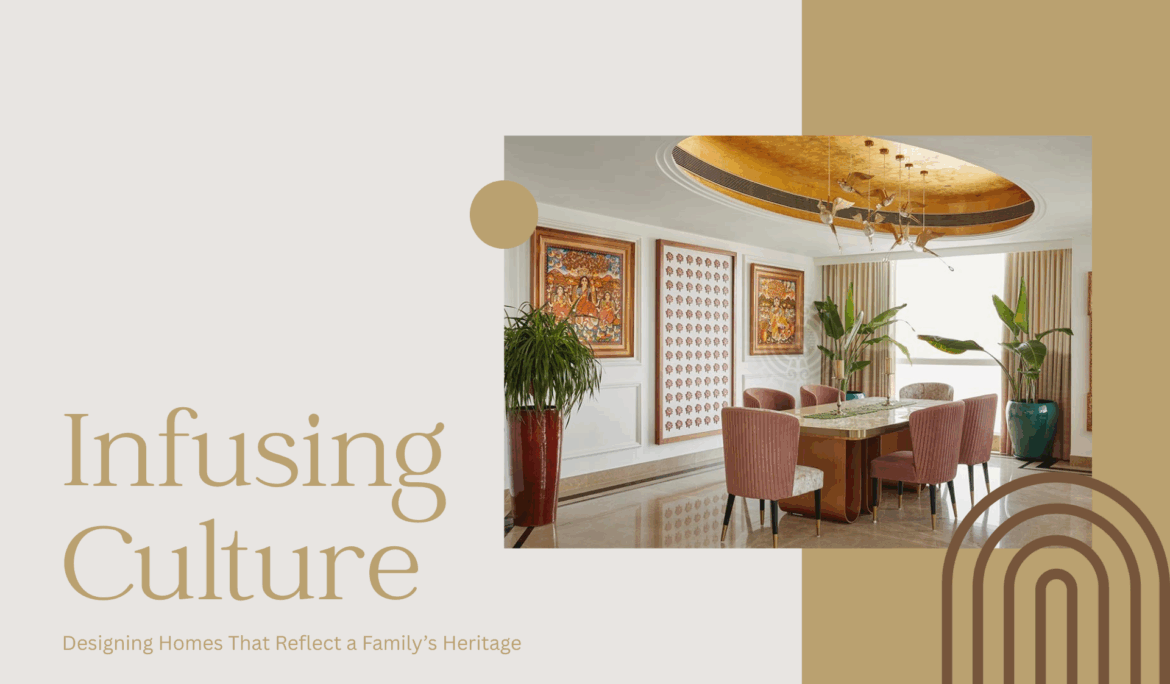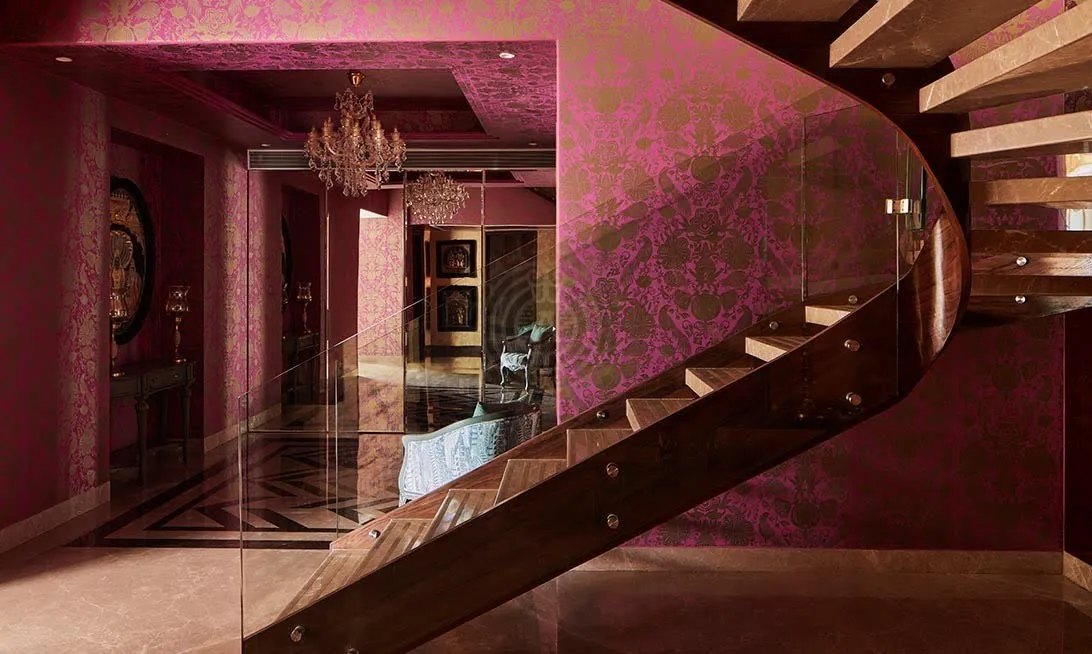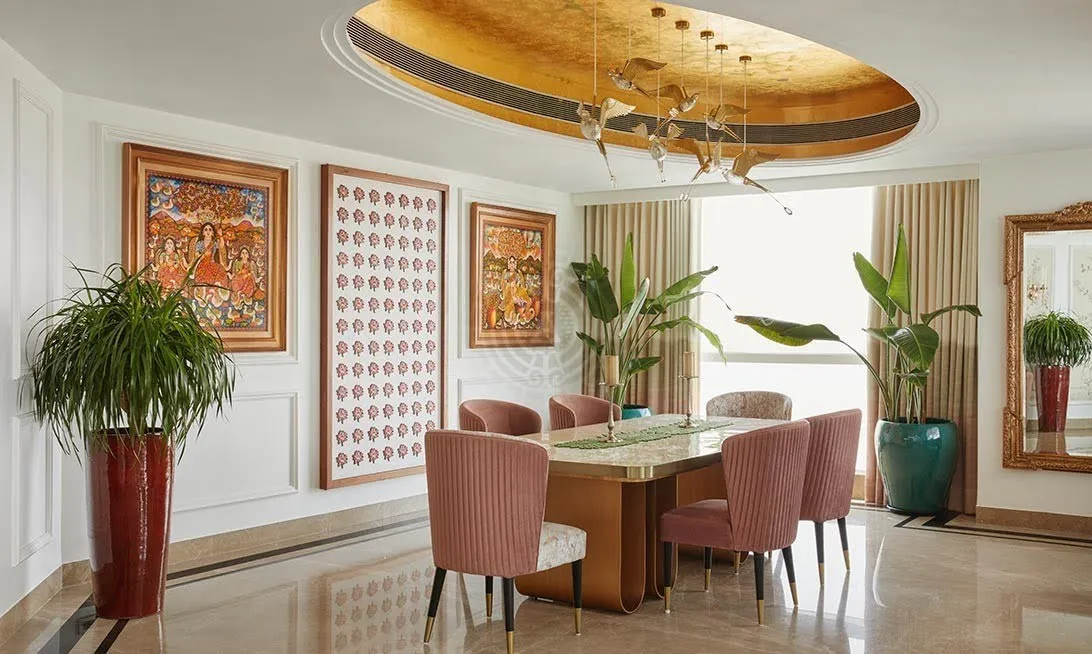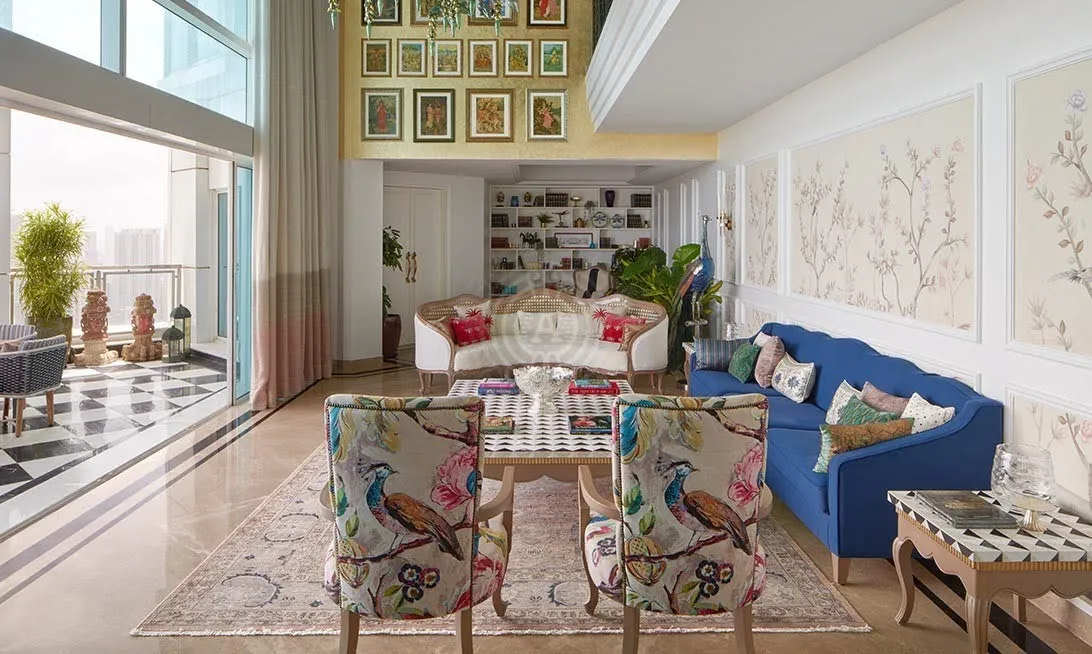Infusing Culture: Designing Homes That Reflect a Family’s Heritage

For many, home is more than just a place to live. It shows who they are, their history, and their cultural roots. Cultural heritage shapes our lives, guides our values, and ties us to our past. In home design, adding elements of heritage makes a space truly personal and meaningful.

A luxury interior designer in India can mix traditional touches with modern styles. This creates a unique space that honors a family’s heritage. Such a home is not only beautiful but also holds deep significance.
Key Takeaways
- Cultural heritage is essential in home design.
- Incorporating heritage elements creates a personal living space.
- Luxury interior designers can blend traditional and modern designs.
- Heritage home design connects families to their roots.
- Modern homes can reflect a family’s history and identity.
The Significance of Cultural Heritage in Modern Home Design
Cultural heritage adds depth and character to homes, making them more than just places to live. It creates spaces that are both timeless and modern.
In modern home design, cultural heritage is not just about keeping the past alive. It’s about mixing old traditions with new styles to make a space truly unique. This mix is essential for homes that show a family’s history and culture.
Balancing Tradition and Contemporary Aesthetics
Finding a balance between old and new is crucial in modern home design. It means picking traditional elements that mean something to the family. Then, these elements are woven into a modern design.
Creating Spaces That Tell Your Family’s Story
Interior designers are key in making spaces that tell a family’s story. By adding elements that show a family’s culture, designers create homes that are not just pretty but also full of meaning.
In the end, adding cultural heritage to modern home design makes spaces rich in history and beauty. It gives a sense of connection to the past.
Why Hire a Luxury Interior Designer in India for Heritage Homes?
Looking to add cultural richness to your home? A luxury interior designer in India is your best bet. They help create spaces that honor your family’s history and add modern comforts.
1. Expertise in Blending Cultural Elements with Modern Living
A luxury interior designer in India knows how to mix cultural elements with today’s living. They use traditional motifs, colors, and textures in modern designs. This creates a space that’s both unique and personal.
2. Access to Artisans and Traditional Craftspeople
Hiring a luxury interior designer in India means tapping into a network of skilled artisans. They can add authentic, handmade pieces to your Traditional Opulence. This boosts its cultural authenticity and beauty.
3. Navigating Regional Design Influences Effectively
India’s diverse regions offer unique architectural styles and materials. A luxury interior designer in India knows how to use these influences. They design your heritage home to fit its local culture while showing your personal style.
Choosing a luxury interior designer in India means getting someone who knows how to blend old and new. They also handle the complexities of regional design. This way, your home truly reflects your family’s heritage and cultural identity.
Architectural Elements That Honor Indian Heritage
Homeowners can honor India’s rich architectural heritage by creating spaces that reflect their cultural roots. This heritage is a mix of various architectural styles from different regions and cultures.
1. Traditional Courtyard Designs for Modern Homes
For centuries, traditional courtyards have been a key part of Indian architecture. They offer a peaceful, private area in homes. Modern homes can still have these courtyards, creating a calm spot in busy cities.
Adding water features, greenery, and traditional craftsmanship can make these spaces even more special.
2. Incorporating Regional Architectural Styles
India’s diverse regions offer a wealth of architectural inspiration. Each region, like Kerala, Rajasthan, and Gujarat, has its own unique style.
-
Kerala-Inspired Elements
Kerala’s architecture is famous for its natural materials, sloping roofs, and detailed wood carvings. Adding these elements to modern homes can bring elegance and cultural depth.
-
Rajasthani and Gujarati Influences
Rajasthan and Gujarat are known for their grand, ornate styles. They use bright colors, intricate mirror work, and detailed carvings. These elements can add luxury to modern homes.
-
Bengali and Eastern Indian Architectural Features
The architecture of Eastern India, especially Bengal, features sloping roofs, wooden elements, and a mix of traditional and colonial styles. Using these features in home design can create a space that is both unique and culturally rich.
Curating the Perfect Color Palette for Heritage-Inspired Spaces
The right color palette can take you back in time. It’s key in heritage-inspired interior design. A well-chosen color scheme brings warmth and richness, linking past and present.
Traditional Indian Color Schemes Reimagined
Traditional Indian colors are full of life and depth. They come from natural dyes and pigments. Mixing rich jewel tones like emerald green and sapphire blue with warm earthy hues is a modern twist.
Regional Color Influences and Their Modern Applications
India’s different regions have their own color styles. Rajasthan is known for bold reds and oranges, while South India has soothing blues and greens. Designers can use these colors to honor heritage and show personal style.
Creating Harmony with Complementary Hues
Creating a harmonious color palette is all about balance. Pairing traditional colors with complementary ones makes them stand out. For example, terracotta looks great with soft cream or pale gray, adding depth.
Natural Materials That Celebrate Indian Craftsmanship
Natural materials have been key in Indian craftsmanship for ages. They offer many options for designing homes inspired by heritage. The rich culture of India shines through in these materials, adding warmth and character to any space.
Incorporating Teak and Indigenous Woods
Teak and indigenous woods are loved for their strength and beauty. Teak stands out for furniture making because it resists decay and insects. Indigenous woods bring unique grain patterns and textures, making any room special.
Stone, Laterite, and Terrazzo Applications
Stone, laterite, and terrazzo are great for many uses, from floors to decor. Laterite, a raw sedimentary rock, creates rustic, earthy looks. Terrazzo, made from marble, quartz, or granite, is durable and beautiful.
Rattan, Bamboo, and Natural Fiber Elements
Rattan, bamboo, and natural fibers make for light, eco-friendly furniture and decor. Rattan is great for its flexibility and lasting quality, perfect for detailed designs. Bamboo, known for being sustainable, is used in floors, walls, and more.
Using these natural materials in your home design celebrates Indian craftsmanship. It creates a space that’s both culturally rich and visually stunning.
Lighting Fixtures That Blend Tradition with Modern Flair
Lighting fixtures that mix old and new can be the heart of any room. They combine classic designs with today’s needs. This way, homeowners can make a space that celebrates their cultural roots.

1. Traditional Lamp Designs with Contemporary Function
Old lamp designs can get a new life with today’s materials and tech. Adding handcrafted elements to these designs brings heritage into today’s homes.
2. Creating Ambiance Through Heritage-Inspired Lighting
Lighting that draws from heritage can change a room’s feel. Using warm, earthy tones and classic patterns makes a space cozy and welcoming. It shows off the homeowner’s cultural background.
3. Statement Fixtures as Cultural Focal Points
Lighting that stands out can highlight a family’s rich history. These pieces can spark conversations with their intricate designs and traditional craftsmanship.
Choosing lighting that mixes old and new shows respect for heritage. It also lets homeowners express their personal style in their homes.
Textiles and Fabrics That Tell Cultural Stories
Cultural stories are woven into our living spaces through textiles and fabrics. These elements add beauty and connect us to our heritage. They bridge generations, keeping our traditions alive.
Handwoven Textiles in Modern Interiors
Handwoven textiles bring tradition into our homes. They are made with techniques passed down through generations. Each piece is unique and carries deep cultural meaning.
Adding these textiles to modern interiors adds depth and character. They make our spaces more interesting and meaningful.
Tapestries and Wall Hangings as Cultural Statements
Tapestries and wall hangings are more than decorations. They tell stories of our cultural heritage. They add cultural depth and visual interest to any room.
These pieces can be found from local artisans. This ensures the craftsmanship and story behind them are preserved.
Cushions and Soft Furnishings with Traditional Patterns
Cushions and soft furnishings with traditional patterns enhance a room’s cultural ambiance. They can be easily added to existing decor. This provides a subtle yet effective way to bring cultural heritage into our homes.
By choosing textiles and fabrics rich in cultural tradition, we create spaces that reflect our style and honor our heritage. This way, we can celebrate our family’s history in our homes.
Flooring Choices That Honor Traditional Craftsmanship
Choosing flooring that honors your family’s heritage is a beautiful way to show respect for tradition. The right flooring can make your home look great and connect you to your cultural roots.
Reimagining Traditional Tile Patterns
Traditional tile patterns, like mosaic designs and geometric shapes, can be updated for today’s homes. These designs, inspired by local traditions, bring a special touch to any room.
Incorporating traditional tile patterns into your flooring connects you to the past. It also shows your love for skilled craftsmanship.
Wooden Flooring with Cultural Significance
Wooden flooring is a great way to honor traditional craftsmanship. Some woods and finishes have deep cultural meanings, making them perfect for heritage homes.
Teak and indigenous woods are favorites for flooring. They’re not just durable but also carry important cultural and historical values.
Terrazzo and Modern Interpretations of Classic Floors
Terrazzo flooring is rich in history and offers a chance to mix old and new. Modern terrazzo can use many materials and patterns, making it ideal for homes that value heritage.
By choosing terrazzo flooring, you can honor tradition while also enjoying modern style.
Accent Walls and Focal Points Inspired by Indian Art
Indian art is full of inspiration for making unique accent walls and focal points. Homeowners can add cultural depth to their homes by using traditional elements.
Incorporating Traditional Artwork in Modern Spaces
Traditional Indian artwork, like paintings and prints, can make stunning accent walls. Frame them in intricately carved wooden frames for a cultural touch. Indian art pieces can be the heart of any room, bringing warmth and character.

Intricately Carved Wooden Elements as Focal Points
Intricately carved wooden elements, like panels or screens, are beautiful focal points. They often reflect Indian mythology and heritage, adding tradition to modern spaces. They can separate areas or stand alone as art.
Wall Treatments Inspired by Indian Mythology and Heritage
Wall treatments inspired by Indian mythology can turn a room into a culturally rich space. Mural painting or intricate tile work can create unique accent walls with stories. These elements make a space beautiful and connect it to a cultural narrative.
By carefully adding these elements, homeowners can make spaces that are both beautiful and deeply rooted in culture.
Blending Indoor and Outdoor Spaces in Heritage-Inspired Design
Heritage-inspired design combines indoor and outdoor spaces, showing a deep connection to culture. It creates a living space that respects tradition and welcomes modern life.
Modern Interpretations of Traditional Courtyards
Traditional courtyards are a key part of Indian architecture, offering a peaceful outdoor area. Today, they blend old charm with new design. Large sliding glass doors and minimalist landscaping help merge indoors and outdoors smoothly.
Creating Seamless Transitions Between Indoors and Outdoors
Designers use large windows and doors to connect indoor and outdoor areas. This improves natural light and makes spaces feel connected. Using similar flooring materials and color schemes inside and out also helps.
Water Features and Natural Elements in Home Design
Water features and natural elements add peace and a link to nature in heritage design. Adding water features like fountains or small ponds and using natural materials such as stone and wood creates a soothing atmosphere.
Heritage-inspired homes blend indoor and outdoor spaces beautifully. They balance cultural heritage with modern comfort, offering a rich living experience.
Multi-Generational Living Spaces That Honor Family Heritage
Multi-generational living spaces are special. They mix old family traditions with today’s needs. As families get bigger, their homes need to change to fit everyone.
Designing Homes That Accommodate Extended Families
Creating homes for big families takes planning. It’s important to make communal areas for family time. At the same time, private spaces are needed for alone time.
Creating Spaces for Heirlooms and Items Passed Down Through Generations
Adding heirlooms to your home is meaningful. It shows respect for your family’s past. Displaying these items in a thoughtful way brings a sense of history to your home.
Balancing Privacy and Communal Living in Heritage Homes
It’s key to find a balance in multi-generational homes. Designers aim to make a space that’s both private and communal. This way, everyone’s needs are met, and family unity is encouraged.
Bringing Your Heritage Home to Life: The Perfect Harmony of Past and Present
Making a heritage home that mixes the old and new is a special skill. It needs a deep understanding of cultural heritage and modern luxury. A Celebrity Interior Designer can help you achieve this perfect blend. They make your home rich with traditional touches and modern comforts.
The secret to a great heritage home design is finding a balance. It’s about keeping cultural heritage alive while adding modern touches. By using old architectural details like intricate carvings and classic courtyards with new materials, you create a unique space.
A luxury interior designer in India can help pick the right mix of old and new for you. They ensure your heritage home honors your family’s history and is also a cozy place to live today. With their help, you can make your heritage home a vibrant mix of past and present.
FAQ
1. What is the importance of cultural heritage in modern home design?
Cultural heritage is key in modern home design. It lets families show their history and culture in their homes. This creates a sense of identity and belonging.
2. How can I balance traditional elements with contemporary aesthetics in my home?
To mix old and new, use traditional architectural features in your modern home. Think about adding carved wooden doors or traditional tile patterns. This blends the past with today’s style.
3. What are the benefits of hiring a luxury interior designer in India for heritage homes?
A luxury interior designer in India can merge cultural elements with modern living. They have access to traditional artisans and know how to use regional design influences. This makes your home unique and culturally rich.
4. How can I incorporate regional architectural styles into my home design?
To add regional styles to your home, look at different areas in India like Kerala, Rajasthan, or Bengal. Use traditional courtyard designs, local colors, or materials. This brings a unique touch to your home.
5. What natural materials can I use to celebrate Indian craftsmanship in my home?
Celebrate Indian craftsmanship with natural materials like teak, indigenous woods, stone, and more. These materials show off their unique qualities and add beauty to your home.
6. How can I create a color palette that honors my family’s heritage?
To honor your family’s heritage, use traditional Indian colors and regional influences. Reimagine them in a modern way. This creates a unique and meaningful color palette for your home.
7. What role do textiles and fabrics play in narrating cultural stories in home design?
Textiles and fabrics are crucial in telling cultural stories in home design. They can include handwoven items, tapestries, and traditional patterns. These add depth and cultural significance to your home’s story.
8. How can I blend indoor and outdoor spaces in heritage-inspired design?
To mix indoor and outdoor spaces, create modern versions of traditional courtyards. Make seamless transitions and add water features and natural elements. This blurs the lines between inside and outside.
9. What are the key considerations when designing multi-generational living spaces?
Designing for extended families means accommodating everyone. Create spaces for family heirlooms and balance privacy with communal areas. This ensures a harmonious and functional home for all.


